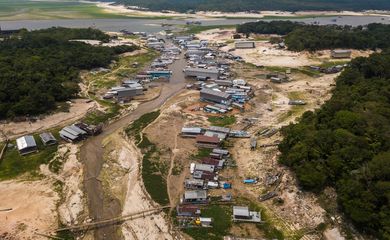Traditional amazonian community hosts international competition

Accustomed to hosting tourists from all over the world, the community of Tumbira, located in the Negro River Sustainable Development Reserve in the state of Amazonas, will welcome international teams throughout July. These teams are not only eager to experience the Amazon firsthand but also to study and document its diverse life forms and habitats. Tumbira is the site of the final round of the Xprize Rainforest, one of the world's largest tropical forest biodiversity mapping competitions. This event challenges participants to use innovative technologies to accelerate the monitoring of tropical biodiversity.

The competition, which began in 2019, started with the participation of 300 teams of scientists from several nationalities, backgrounds, and fields of expertise.
After several stages of research, development, and implementation, a competitive semi-final held in the rainforests of Singapore narrowed the field to six teams. These teams have now arrived in Manaus for the final phase, where they will compete for a share of the $10 million prize, which will be divided among the three groups that present the best solutions for monitoring and preserving the rainforest.
At the opening of the final phase on July 4, Ana Lúcia Vilela, president of the Alana Institute—the socio-environmental impact group funding the competition—emphasized that while those living in the forest possess extensive knowledge, they need to advance further in seeking solutions to the emerging challenges, which predominantly impact those who are its most dedicated protectors.
"We know that the Amazon is also home to a diverse population, including large and medium-sized cities, over 180 indigenous peoples, many of whom are isolated, more than a thousand quilombola communities, rubber tappers, and other traditional communities. Archaeological research shows that these forests have always been inhabited," said Vilela.
She also explained that the competition stemmed from a troubling realization in 2019: "the annual loss of biodiversity surpassed the capabilities of the technologies then available to map it."
Vilela believes that the knowledge generated by the competition should positively impact future generations, particularly those living in the forest. "Children are the most affected by preventable tragedies. We were shocked to see images of Yanomami children suffering from malnutrition and diseases caused by illegal mining, which contaminates rivers, kills animals, and depletes food supplies. These are unthinkable and unacceptable threats in a country that has embraced human rights as a founding principle since its inception," said the institute's president.
These future generations include children like Adrian Garrido Macedo and Nicolas de Alencar Santos, residents of the Tumbira community, where the final tests of the competition will take place. Last Saturday (Jul. 6), they watched attentively as the equipment brought by the first team to have their technologies evaluated in the forest was unloaded.
Until July 23, each of the six groups will be evaluated by the judges on both qualitative and quantitative terms related to data collection and production. They will have 24 hours to gather bioacoustic information, images, and DNA samples from 100 hectares of the conservation unit, followed by 48 hours to process the data in real time and demonstrate scalability. This entire process will also be observed by the local residents.
Transformation
Roberto Macedo, a community leader and a beacon of sustainability in Tumbira, is an example of transformation through knowledge. At the age of 12, he began felling trees to harvest wood, a practice passed down by his father and grandfather, who were also loggers. For 26 years, this was the only survival model he knew.
In 2008, with the creation of the conservation unit, the community began to see new schools and job opportunities emerge. As the forest started to recover, so did the lives of its residents. With support from the Sustainable Amazon Foundation (FAS), Macedo transitioned into tourism and became one of the foremost advocates for preserving the standing forest. "Before, we valued a felled tree for its timber, but now we see the countless opportunities a living tree brings to our community. Tourism has provided a way for us to work within the forest without having to leave it. Today, we focus on sustainability with local knowledge that champions the Living Amazon."
Technology
The Negro River Sustainable Development Reserve is a conservation unit spanning over 103,000 hectares, covering the municipalities of Novo Airão, Iranduba, and Manacapuru. A total of 580 families reside within the reserve, with 140 of them living in the Tumbira community, which is part of the Iranduba municipality.
Willian Soares Mendes, a resident of the conservation unit, believes that selecting the reserve for the competition's final round underscores the importance of conserving this area. "The technology being introduced to our forest is crucial for identifying problems and understanding its future. It helps us preserve the forest, which is vital to our well-being. Without this forest standing, this event wouldn't even be possible here," says the FAS employee.
The tests will continue in the conservation unit until July 23, but the residents hope that the knowledge gained and recorded through biodiversity mapping will increasingly support the community's ability to live in and care for the forests. "Combining local knowledge with academic insights through technology creates a powerful synergy that can promote local development by valuing living nature and protecting the forest for our children and grandchildren, who will become the region's future scientists and researchers," concludes Roberto Macedo.



